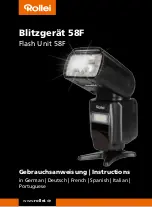
36
Spyder3 SC-34 Color Camera User's Manual
03-032-20116-01
Teledyne DALSA
A nalog Processing
Op tim izing offset p erform ance and gain in the analog d om ain allow s you to achieve a better signal-to-
noise ratio and d ynam ic range than you w ou ld achieve by trying to op tim ize the offset in the d igital
d om ain. As a resu lt, p erform all analog ad ju stm ents p rior to any d igital ad ju stm ents.
Analog gain is m u ltip lied by the analog signal to increase the signal strength before the A/ D conversion.
It is u sed to take ad vantage of the fu ll d ynam ic range of the A/ D converter. For exam p le, in a low light
situ ation the brightest p art of the im age m ay be consistently com ing in at onl y 50% of the DN . An analog
gain of 6 d B (2x) w ill ensu re fu ll u se of the d ynam ic range of the A/ D converter. Of cou rse the noise is
also increased . N ote: To m aintain valid LUT calibration, u se the
ssg
com m and .
Digital Processing
To op tim ize cam era p erform ance, d igital signal p rocessing shou ld be com p leted after any analog
ad ju stm ents.
Fixed p attern noise (FPN ) calibration (calcu lated u sing the
ccf
com m and ) is u sed to su btract aw ay
ind ivid u al p ixel d ark cu rrent.
Photo-Resp onse N on-Uniform ity (PRN U) coefficients (calcu lated u sing the
cpa
com m and ) are u sed to
correct the d ifference in resp onsivity of ind ivid u al p ixels (i.e. given the sam e am ou nt of light d ifferent
p ixels w ill charge u p at d ifferent rates) and the change in light intensity across the im age either becau se
of the light sou rce or d u e to op tical aberrations (e.g. there m ay be m ore light in the ce nter of the im age).
PRN U coefficients are m u ltip liers and are d efined to be of a valu e greater than or equ al to 1. This ensu res
that all p ixels w ill satu rate together.
Backgrou nd su btract (
ssb
com m and ) and system (d igital) gain (
ssg
com m and ) are u sed to increase
im age contrast after FPN and PRN U calibration. It is u sefu l for system s that p rocess 8-bit d ata bu t w ant
to take advantage of the camera‘s 12 bit digital processing chain. For example, if you find that your image
is consistently betw een 128 and 255 DN (8 bit), you can su btract off 128 (
ssb 2048
) and then m u ltip ly by
2 (
ssg 0 8192
) to get an ou tp u t range from 0 to 255 DN .
Calibrating the Camera to Remove Non-Uniformity (Flat Field
Correction)
Flat Field Correction Overview
This cam era has the ability to calcu late correction coefficients in ord er to rem ove non -u niform ity in the
im age. This vid eo correction op erates on a p ixel-by-p ixel basis and im p lem ents a tw o-p oint correction for
each p ixel. This correction can red u ce or elim inate im age d istortion cau sed by the follow ing factors:
Fixed Pattern N oise (FPN )
Photo Resp onse N on Uniform ity (PRN U)
Lens and light sou rce non -u niform ity
Correction is im p lem ented su ch that for each p ixel:
V
ou tp u t
=[(V
inp u t
- FPN ( p ixel ) - black level offset) * PRN U(p ixel) – Backgrou nd Su btract] x System Gain
w here
V
ou tp u t
=
d igital ou tp u t p ixel valu e
V
inp u t
=
d igital inp u t p ixel valu e from the CCD
PRN U( p ixel)
=
PRN U correction coefficient for this p ixel
FPN ( p ixel )
=
FPN correction coefficient for this p ixel
Backgrou nd
=
backgrou nd su btract valu e
All manuals and user guides at all-guides.com
all-guides.com
















































